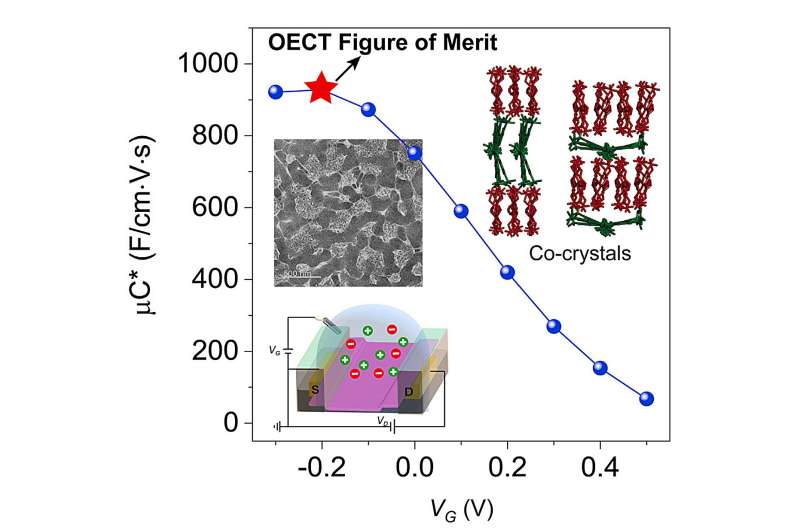This article has been reviewed according to Science X's editorial process and policies. Editors have highlighted the following attributes while ensuring the content's credibility:
fact-checked
peer-reviewed publication
trusted source
proofread
Modified soft material promises better bioelectronics

The scientific community has long been enamored of the potential for soft bioelectronic devices, but has faced hurdles in identifying materials that are biocompatible and have all of the necessary characteristics to operate effectively. Researchers have now taken a step in the right direction, modifying an existing biocompatible material so that it conducts electricity efficiently in wet environments and can send and receive ionic signals from biological media.
Their paper, "Electrostatic Self-Assembly Induces Efficient Mixed Transport and Water Stability in PEDOT:PSS for High Performance OECTs," is published in the journal Matter.
"We're talking about an order-of-magnitude improvement in the ability of soft bioelectronic materials to function efficiently in biological environments," says Aram Amassian, co-corresponding author of a paper on the work and a professor of materials science and engineering at North Carolina State University. "This is not an incremental advance."
There is tremendous interest in creating organic bioelectronics and organic electrochemical transistors (OECTs), with a wide range of biomedical applications. However, one limiting factor is identifying nontoxic materials that can conduct electricity, interacting with ions—which is critical to functioning in biological environments, and operating efficiently in the aqueous, water-based environments of biological systems.
One material of interest has been PEDOT:PSS, which is a nontoxic polymer that is able to conduct electricity. PEDOT:PSS is used to create thin films which are effectively fiber networks that are only nanometers wide. Electrical current can run through the fibers, which are also sensitive to ions in their environment.
"The idea is that, because ions interact with the fibers—and affect their conductivity—PEDOT:PSS can be used to sense what is happening around the fibers," says Laine Taussig, co-first author of the paper and a recent Ph.D. graduate of NC State who now works at the Air Force Research laboratory.
"Essentially, PEDOT:PSS would be able to monitor its biological environment. But we could also use the electric current to influence the ions surrounding the PEDOT:PSS, sending signals to that biological environment," says Masoud Ghasemi, co-first author and a former postdoctoral fellow at NC State who is now a postdoctoral fellow at Penn State.
However, PEDOT:PSS's structural stability declines significantly when placed in aqueous environments—like biological systems. That's because PEDOT:PSS is a single material made from two components: the PEDOT, which conducts electricity and is not soluble in water; and PSS, which responds to ions, but is water soluble. In other words, the PSS makes the material start to fall apart when it comes into contact with water.
Previous efforts to stabilize the structure of PEDOT:PSS have been able to help the material withstand aqueous environments, but have both hurt PEDOT:PSS's performance as a conductor and made it more difficult for ions to interact with the material's PSS components.
"Our work here is important, because we've found a new way to make a PEDOT:PSS that is structurally stable in wet environments and able to both interact with ions and conduct electricity very efficiently," says George Malliaras, co-corresponding author and Prince Philip Professor of Technology at Cambridge University.
Specifically, the researchers start with PEDOT:PSS in solution and then add ionic salts. Given time, the ionic salts interact with the PEDOT:PSS, causing it to self-assemble into fibers with a unique structure that remains stable in wet environments. This modified PEDOT:PSS is then dried and the ionic salts rinsed off.
"We already knew that ionic salts could affect PEDOT:PSS," Amassian says. "What's new here is that by giving the ionic salts more time to see the full extent of those effects, we modified the crystalline structures of the PEDOT and the PSS to essentially lace themselves together at the molecular scale. This makes the PSS impervious to the water in the environment, allowing the PEDOT:PSS to maintain its structural stability at the molecular level."
"The change is also hierarchical, meaning that there are shifts at the molecular level all the way up to macroscale," says Yaroslava Yingling, co-author of the paper and Kobe Steel Distinguished Professor of Materials Science and Engineering at NC State. "The ionic salts cause the PEDOT:PSS to essentially reorganize itself into a phase that resembles a web-like gel that is preserved in both dry and wet environments."
In addition to being stable in aqueous environments, the resulting films retain their conductivity. What's more, because the PEDOT and PSS are tightly interwoven, it's easy for ions to reach and interact with the PSS component of the material.
"This new phase of PEDOT:PSS was used to create OECTs by our collaborators at Cambridge," Amassian says. "And those OECTs set a new state-of-the-art standard in both volumetric capacitance and electronic carrier mobility. In other words, it's the new gold standard in both conductivity and ion responsiveness in bio-friendly electronics."
"Given that PEDOT:PSS is transparent, flexible, stretchable, conductive and biocompatible, the range of potential applications is exciting—extending well beyond the biomedical sector," says Enrique Gomez, co-corresponding author and a professor at Penn State.
The paper was co-authored by Albert Kwansa, an assistant research professor of materials science and engineering at NC State; Nathan Woodward, a Ph.D. student at NC State; Sanggil Han and Scott Keene of Cambridge; and Ruipeng Li of Brookhaven National Laboratory.
More information: Electrostatic Self-Assembly Induces Efficient Mixed Transport and Water Stability in PEDOT:PSS for High Performance OECTs, Matter (2024). DOI: 10.1016/j.matt.2023.12.021. www.cell.com/matter/fulltext/S2590-2385(23)00634-3
Journal information: Matter
Provided by North Carolina State University





















